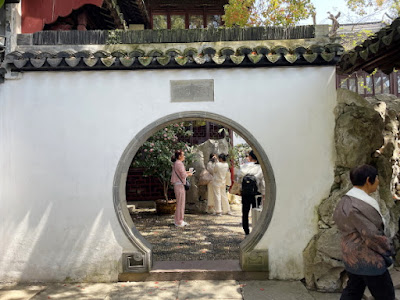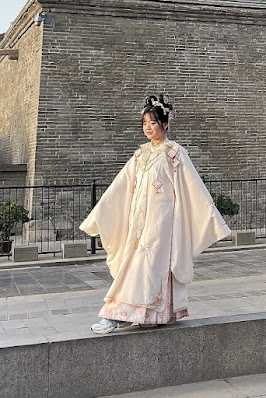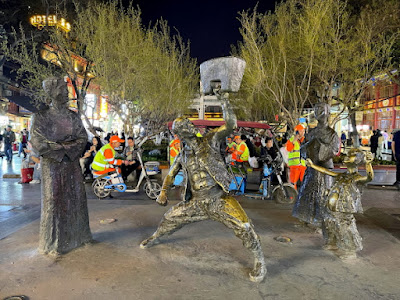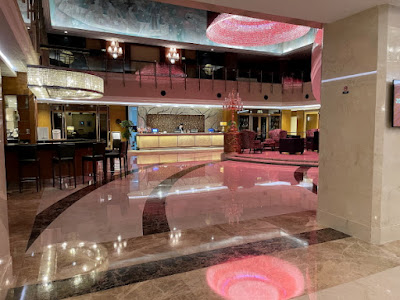Yu Garden was built in 1559 during the reign of Ming Emperor Jiajing. The garden is located on two hectares (4.94 acres) of land.
While wandering around the complex we found a rock with some gold Chinese writings. I do not know what the writing said, but it think it had something to do with the actual garden entrance.
A guide book stated that the garden has four features - Architecture, Rocks, Water, and Flower and Trees.
Architecture represents the temples, pavilions, galleries, halls, bridges, kiosks, and towers for viewing different features of the garden from different points of view.
Rocks represent virtue, stability, and endurance. A single "scholar rock" represents a mountain and a row of rocks represents a mountain range.
Water represents dreams and the infinity of spaces. The softness of water contrasts with the solidity of rocks.
Flowers and Trees represent nature in its most vivid form and contrasts with the straight lines of architecture and the permanency and immobility of rocks. Flowers and Trees change continually with seasons and provide sounds and aromas to please visitors.
 |
| Picture by Heather |
 |
| Picture by Kolohe |
The Huxinting Teahouse was built in 1784 over a small pond in the Gardens. There is a zigzag bridge leading to the tea house that protects visitors because it is believed that evil spirits can not turn corners
 |
| Picture by Kolohe |
 |
| Picture by Kolohe |
 |
| Picture by Kolohe |
 |
| Picture by Kolohe |
 |
| Picture by Kolohe |
Along the top of a wall in the Gardens is a dragon that only has four claws, so as not to incur the wrath of the emperor's five-clawed dragon.
 |
| Picture by Kolohe |
As we were leaving Yu Gardens, we could see the Shanghai Business District skyline in the distance. We had to return to Shanghai for our return flight home, so we decided to visit the business district when we returned.
Since it is about 1400 km (870 miles) from Shanghai to Xi'An, we decided to fly out of Shanghai Hongqiao Airport, which is a much calmer airport and offers a better selection of internal China flights.
On the way to the airport, I was amazed at the many different building architectural designs. While most high-rise office buildings in the US are just rectangular in shape, in China they have some really unusual shaped buildings.
 |
| Picture by Kolohe |
 |
| Picture by Kolohe |
 |
| Picture by Kolohe |
 |
| Picture by Kolohe |
Restrooms in China are really unique -- there are no seats! You just squat over a hole in the floor. There is typically no toilet paper in the stall, so most people bring their own. And, toilet paper is not flushed down the hole. Used toilet paper is placed in a container by the hole. I photographed a hole in the airport because it was more modern, and there was a toilet paper dispenser on the wall. Kolohe and Heather said they were glad that we did a lot of camping when they were growing up because it did not bother them to squat over a hole instead of having a toilet seat to sit on.
 |
| Picture by Heather |
While we were waiting to board our plane, a little Chinese girl kept entertaining us.
 |
| Picture by Heather |
As we were taxiing to the runway, we noticed a plane that was painted with Disneyland advertising. Woody was inviting everyone to fly to Disneyland.
On the way to Xi'An we flew over a mountain range, but I could not find the name of the mountains on my map.
 |
| Picture by Kolohe |
 |
| Picture by Kolohe |
 |
| Picture by Kolohe |
 |
| Picture by Kolohe |
 |
| Picture by Kolohe |
After arriving in Xi'An, we rode the subway to a stop that was fairly close to the Grand Noble Hotel where we were staying. The hotel is located on the inside of City Wall, which enclosed the original Emperor's Palace.
Even though it was only a few blocks to the hotel, and our luggage had wheels, we still had to carry everything up and down the stairs found at some intersections. If I had to do it again, I would catch a ride in a taxi.
 |
| Picture by Kolohe |
Many people have covers on the fronts of their scooters that protects them while ridding in traffic from small stones that may be dislodged by other scoters and vehicles. The covers also keep their hands protected during hot and cold weather.
 |
| Picture by Kolohe |
 |
| Picture by Kolohe |
After leaving our luggage at the hotel, we walked over to Bell Tower that was built in 1384. Xi'An's Bell Tower is considered to be one of the grandest and best preserved bell towers in China.
For entertainment, many of the local people come to the Bell Tower wearing historical Chinese clothing and allow tourists to take their pictures.
 |
| Picture by Heather |
 |
| Picture by Heather |
We arrived too late to tour Bell Tower, so we walked around the plaza and garden area that was nearby. A lot of people were gathered on the plaza to socialize and enjoy the area's peaceful tranquility. Therefore, I was really surprised when I saw a man painting Chinese characters on the concrete. Then, I found out that he was using water to paint with and the characters had a very short life span.
 |
| Picture by Kolohe |
We walked down to Drum Tower that was not too far away, but it was fenced off for renovation work. By this time we were getting a little tired of walking, so we hired a motorized rickshaw to drive us around for the rest of the evening.
Inside of the City walled area, traffic is a nightmare and a rickshaw is the fastest way to travel. You just need nerves of steel and keep all parts of your body that you want to keep inside of the rickshaw. To make better time, rickshaw drivers play "chicken" with large tourist busses and use sidewalks and parking areas as part of the roadway.
Since we had rented our own rickshaw for the evening, we decided to go outside of the Wall and visit the Great Wild Goose Pagoda. The 64 m (210 ft) pagoda was built in 652 AD in memory of Emperor Gaozong's mother. On the north side of the pagoda were fountains that were timed to music.
 |
| Picture by Heather |
 |
| Picture by Heather |
The Wild Goose Pagoda was closed when we arrived, but we were able to walk around the grounds and watch the fountain show. I do not know the significance of the columns and other displays that were along the street, and I could not find anything in the guide books that explained why they were at this location.
 |
| Picture by Kolohe |
 |
| Picture by Kolohe |
 |
| Picture by Kolohe |
 |
| Picture by Kolohe |
 |
| Picture by Kolohe |
 |
| Picture by Kolohe |
We even found a McDonald's, but we did not stop to get anything to eat.
 |
| Picture by Kolohe |
 |
| Picture by Kolohe |
 |
| Picture by Kolohe |
 |
| Picture by Kolohe |
On the way back to the hotel, we decided to take a detour and visit Bei-Yuan-Men Muslim Cultural Street, also known as the "Muslim Quarter." The area is famous for its food, which includes both Muslim dishes and local Xi'An specialties.
Muslims came to China between 209 BC and 9 AD when Xi'An was the capital city and the starting point for the Silk Road. Diplomatic envoys and merchants from a number of Arabian countries followed the road to Xi'An and then stayed and settled in the area known as "Muslim Street." There are now approximately 60,000 Muslims living in Xi'An. "Muslim Street" is a very popular spot to visit in the evenings.
 |
| Picture by Heather |
 |
| Picture by Kolohe |
 |
| Picture by Kolohe |
 |
| Picture by Kolohe |
 |
| Picture by Kolohe |
 |
| Picture by Kolohe |
 |
| Picture by Heather |
 |
| Picture by Kolohe |
I even found a Dairy Queen. The workers did not speak English, so I just pointed to a picture of the ice cream treat that I wanted. (It tasted a little different than the US DQ ice cream, so they must use some different ingredients.)
 |
| Picture by Kolohe |
 |
| Picture by Kolohe |
After touring around for the evening, our rickshaw driver delivered us back to the Grand Noble Hotel where we were staying.



















































































No comments:
Post a Comment